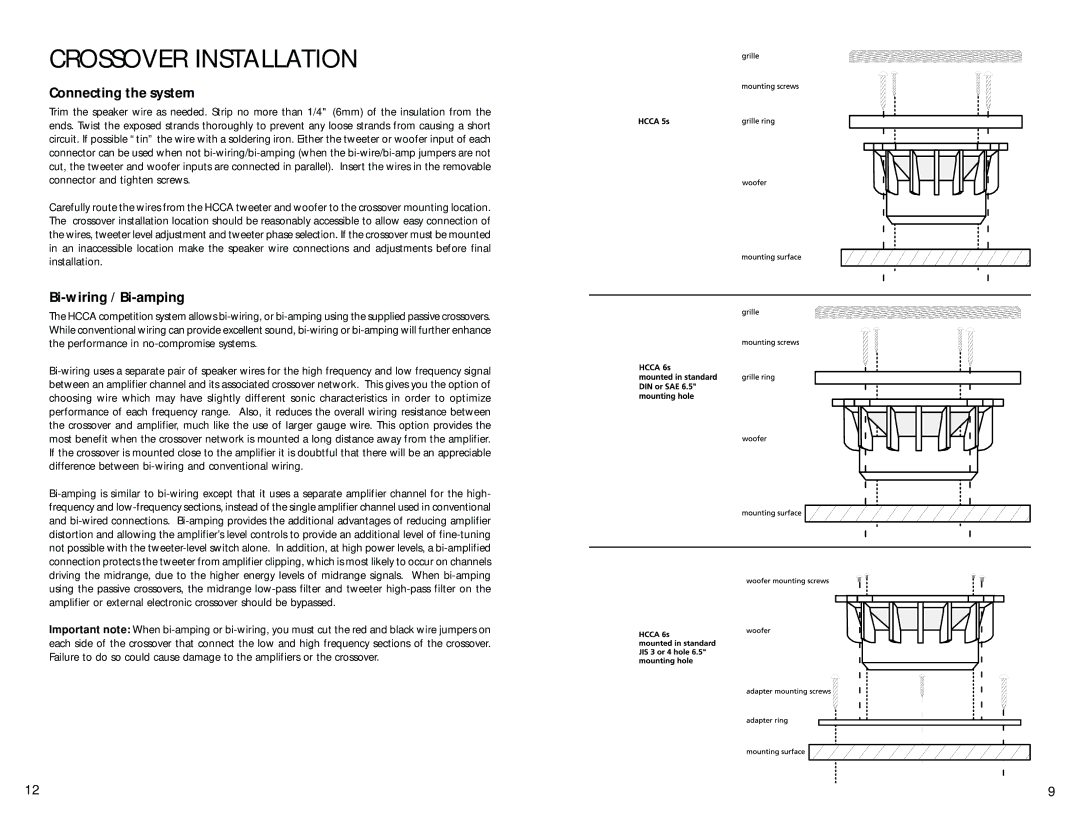CROSSOVER INSTALLATION
Connecting the system
Trim the speaker wire as needed. Strip no more than 1/4" (6mm) of the insulation from the ends. Twist the exposed strands thoroughly to prevent any loose strands from causing a short circuit. If possible “tin” the wire with a soldering iron. Either the tweeter or woofer input of each connector can be used when not bi-wiring/bi-amping (when the bi-wire/bi-amp jumpers are not cut, the tweeter and woofer inputs are connected in parallel). Insert the wires in the removable connector and tighten screws.
Carefully route the wires from the HCCA tweeter and woofer to the crossover mounting location. The crossover installation location should be reasonably accessible to allow easy connection of the wires, tweeter level adjustment and tweeter phase selection. If the crossover must be mounted in an inaccessible location make the speaker wire connections and adjustments before final installation.
Bi-wiring / Bi-amping
The HCCA competition system allows bi-wiring, or bi-amping using the supplied passive crossovers. While conventional wiring can provide excellent sound, bi-wiring or bi-amping will further enhance the performance in no-compromise systems.
Bi-wiring uses a separate pair of speaker wires for the high frequency and low frequency signal between an amplifier channel and its associated crossover network. This gives you the option of choosing wire which may have slightly different sonic characteristics in order to optimize performance of each frequency range. Also, it reduces the overall wiring resistance between the crossover and amplifier, much like the use of larger gauge wire. This option provides the most benefit when the crossover network is mounted a long distance away from the amplifier. If the crossover is mounted close to the amplifier it is doubtful that there will be an appreciable difference between bi-wiring and conventional wiring.
Bi-amping is similar to bi-wiring except that it uses a separate amplifier channel for the high- frequency and low-frequency sections, instead of the single amplifier channel used in conventional and bi-wired connections. Bi-amping provides the additional advantages of reducing amplifier distortion and allowing the amplifier’s level controls to provide an additional level of fine-tuning not possible with the tweeter-level switch alone. In addition, at high power levels, a bi-amplified connection protects the tweeter from amplifier clipping, which is most likely to occur on channels driving the midrange, due to the higher energy levels of midrange signals. When bi-amping using the passive crossovers, the midrange low-pass filter and tweeter high-pass filter on the amplifier or external electronic crossover should be bypassed.
Important note: When bi-amping or bi-wiring, you must cut the red and black wire jumpers on each side of the crossover that connect the low and high frequency sections of the crossover. Failure to do so could cause damage to the amplifiers or the crossover.

